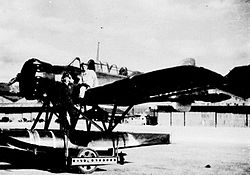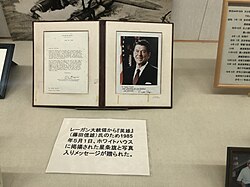Nobuo Fujita
Nobuo Fujita | |
|---|---|
 Nobuo Fujita c. 1942-1945 | |
| Born | 1911 Bungotakada,Ōita,Empire of Japan |
| Died | 30 September 1997 (aged 85) Tsuchiura,Ibaraki,Japan |
| Buried | |
| Allegiance | |
| Service/ | |
| Years of service | 1932–1945 |
| Rank | |
| Battles/wars | World War II |
| Other work | Businessman Unofficial ambassador forBrookings, Oregon. |
Nobuo Fujita(Đằng điền tin hùng,Fujita Nobuo)(1911 – 30 September 1997) was a Japanesenaval aviatorof theImperial Japanese Navywho flew afloatplanefrom the long-rangesubmarine aircraft carrierI-25and conducted theLookout Air Raidsin southernOregonon September 9, 1942, making him the onlyAxispilot during World War II to aerial bomb thecontiguous United States.[1][2][3]Usingincendiary bombs,his mission was to start massive forest fires in thePacific Northwestnear the city ofBrookings, Oregon,with the objective of drawing the U.S. military's resources away from thePacific Theater.The strategy was also later used in the Japanesefire ballooncampaign.
In 1962 Fujita was invited to Brookings where he gave his family's 400-year-old katana to the city in friendship, Fujita later sponsored a trip for Brookings high school students to visit Japan in 1985 and returned to the city again in 1990, 1992, and 1995. In 1997, a few days before his death, Fujita was made an honorary citizen of the city.
Early life and military career[edit]
Nobuo Fujita joined theImperial Japanese Navyin 1932 and became a pilot in 1933. Fujita also had a younger brother who was killed in the war.[4]
Pearl Harbor and U.S. West Coast[edit]

Fujita was on boardI-25during theattack on Pearl Harbor,where theI-25and three other submarines patrolled a line 193 km (120 mi) north ofOahu.Fujita's plane, aYokosuka E14Y"Glen" seaplane, did not function properly, and he was unable to participate in the reconnaissance mission planned before the attack.
After the attack on Pearl Harbor,I-25patrolled along theWest Coast of the United Stateswith eight other submarines. They attacked U.S. shipping before returning to their base inKwajalein Atollin theMarshall Islands.They arrived there on January 11, 1942, to be refueled and refurbished.
South Pacific[edit]
I-25's next mission was to reconnoiter theAustralianharbours ofSydney,MelbourneandHobart,followed by theNew Zealandharbours ofWellingtonandAuckland.On 17 February 1942, Nobuo Fujita took off in the "Glen" for a reconnaissance flight overSydney Harbourto examine the city's airbase. By 07:30, he had returned toI-25,disassembled the "Glen" and stowed it in the water-tight hangar.
The next mission was a similar flight overMelbourne, Australia.Fujita took off from Cape Wickham onKing Islandat the western end ofBass Strait,about halfway betweenVictoriaandTasmania.The floatplane was launched on 26 February at 3AM for its flight to Melbourne overPort Phillip Bay.During the flight, Fujita recorded details of the bayside industrial areas and shipping activity, as well as noting the presence of one light cruiser, and five destroyers.
Fujita's next reconnaissance flight in Australia was over Hobart on 1 March.I-25then headed for New Zealand, where Fujita flew a reconnaissance flight over Wellington on 8 March. He flew over Auckland on 13 March, followed byFijion 17 March. The submarine returned to its base at Kwajalein on 31 March.
Pacific Northwest[edit]
On 28 May, Fujita performed a reconnaissance ofKodiak, Alaska,in preparation for theinvasion of the Aleutian Islands.On 21 June,I-25shelled the U.S. base ofFort Stevens,nearAstoria, Oregon.Fujita was on the deck ofI-25during the attack.
Bombing Oregon[edit]

Fujita himself suggested the idea of a submarine-based seaplane to bomb military targets, including ships at sea, and attacks on the U.S. mainland, especially the strategicPanama Canal.The idea was approved, and the mission was given toI-25.Submarine aircraft carriers such as the giantI-400-class submarineswould be developed specifically to bomb the Panama Canal.
At 06:00 on 9 September,I-25surfaced west of theOregon/Californiaborder where she launched theGlen,flown by Fujita andPetty OfficerOkuda Shoji,with a 154 kg (340 lb) load of twoincendiary bombs.Fujita dropped two bombs, one on Wheeler Ridge onMount EmilyinOregon.The location of the other bomb is unknown. The Wheeler Ridge bomb started a small fire 16 km (9.9 mi) due east ofBrookings,whichU.S. Forest Serviceemployees were able to extinguish.[5]Rain the night before had made the forest very damp, and the bombs were rendered essentially ineffective. Fujita's plane had been spotted by two men, Howard Gardner and Bob Larson, at the Mount Emilyfire lookout towerin theSiskiyou National Forest.Two other lookouts (the Chetco Point Lookout and the Long Ridge Lookout) reported the plane, but could not see it due to heavy fog. The plane was seen and heard by many people, especially when Fujita flew over Brookings in both directions. At about noon that day, Howard Gardner at the Mount Emily Lookout reported seeing smoke. The four U.S. Forest Service employees discovered that the fire was caused by a Japanese bomb. Approximately 27 kg (60 lb) of fragments, including the nose of the bomb, were turned over to theUnited States Army.
After the bombing,I-25came under attack by aUSAAFaircraft on patrol, forcing the submarine to dive and hide on the ocean floor offPort Orford.The American attacks caused only minor damage, and Fujita flew a second bombing sortie three weeks later on 29 September. Fujita used theCape Blanco Lightas a beacon. After 90 minutes flying east, he dropped his bombs and reported seeing flames, but the bombing remained unnoticed in the U.S.
The submarine torpedoed and sank theSSCamden[6]andSSLarry Doheny[7]and then sailed for home. On its way to Japan,I-25sank theSovietsubmarineL-16,which was in transit betweenDutch Harbor, Alaska,andSan Francisco, California,mistaking it for an American submarine (Japan and the USSR were not at war at the time).
The two attacks onOregonin September 1942 were the only enemy aircraft bombings on thecontiguous United Statesand were the second time the continental United States was attacked by such aircraft during World War II, following thebombing of Dutch HarborinUnalaska, Alaskathree months earlier.
Post-bombing[edit]
Fujita continued as an Imperial Japanese Navy pilot, mainly in reconnaissance duties, and was promoted to the rank ofEnsign.In 1943 he was transferred to the Kashima Naval Air Corps, a seaplane training and later a mainland air defense unit, where he served as an instructor attached to the aviation squadron. In February 1945 while flying aMitsubishi F1Mreconnaissance floatplane Fujita was involved in the interception and unconfirmed downing of an AmericanGrumman F6F Hellcat.[8]
Just before the end of the war Fujita volunteered to join theKamikaze Special Attack Forceand he was transferred to the Kawa Naval Air Corps where he trained kamikaze pilots and prepared to take part in an attack himself.Kawanishi N1K Kyōfūfloatplanes were used for the training but because of multiple factors including poor visibility and the difficulty for crew members with little flight experience to take off and land on water Fujita did not perform any missions before the war's end.[9]After the war but before his demobilization Fujita was promoted toSub-Lieutenant.
Later life[edit]
After the war he opened a hardware store inIbaraki Prefecture,and later worked at a company making wire.[4]
Fujita was invited to Brookings in 1962 by the localJaycees,after theJapanese governmentwas assured he would not be tried as awar criminal.He gave the City of Brookings his family's 400-year-oldkatanain friendship. Fujita had intended to use the sword to commitseppukuif he should be arrested as a suspect of war crime.[4]Although his visit still raised some controversy the town treated him with respect and affection, while US PresidentJohn F. Kennedycongratulated the town on their efforts to promote international friendship.[10][11]
Impressed by his welcome in the United States, during his visit, he promised to invite Brookings students to Japan. Despite the bankruptcy of his company, Fujita made good on his promise by co-sponsoring the visit of three female students fromBrookings-Harbor High Schoolto Japan in 1985.[12][13]During the visit, Fujita received a US flag flown over theUS Capitol Buildingand a dedicatory letter from an aide ofPresident Ronald Reagan"with admiration for your kindness and generosity." Both are now on display at the Nobuo Fujita Corner of theJapan Ground Self-Defense Force'sCamp Kasumigaura Public Relations Center nearTsuchiura.

Fujita returned to Brookings in 1990, 1992, and 1995. In 1992, he planted a tree at the bomb site as a gesture of peace.[14]In 1995, he moved the samurai sword from the Brookings City Hall into the new library's display case. Fujita helped to gather money to build the library.[15]He was later named an "ambassador of goodwill" by the city for his continued peace efforts.[16]
Fujita was made an honorary citizen of Brookings while hospitalized for lung cancer inTsuchiura,he died a few days later on September 30, 1997, at the age of 85.[14][17]In October 1998, his daughter, Yoriko Asakura, buried some of Fujita's ashes at the bomb site near Brookings. According to local resident Brenda Jacques his daughter told her that“part of [her father’s] soul would forever be flying overMount Emily”.[11]

See also[edit]
References[edit]
- ^Webber, Bert (1985) "Silent Siege-II Japanese Attacks on North America in WWII." Webber Research Group,ISBN0-936738-26-X,P. vi
- ^Coyle, Brendan (2002) "War On Our Doorstep, The Unknown Campaign On North America's West Coast", p. 148
- ^"Nobuo Fujita World War II Database".Retrieved6 July2011.
- ^abcKristof, Nicholas D. (3 October 1997)."Nobuo Fujita, 85, Is Dead; Only Foe to Bomb America".The New York Times.Retrieved20 May2010.
- ^McArthur, Lewis A.;McArthur, Lewis L.(1992) [1928].Oregon Geographic Names(6th ed.). Portland, Oregon:Oregon Historical SocietyPress. p. 898.ISBN978-0875952369.
- ^"SS Camden".Wreck Site.2 February 2008.Retrieved23 June2017.
- ^"SS Larry Doheny".Wreck Site.14 February 2008.Retrieved23 June2017.
- ^Ushio Shobo Kojinshinsha "Maru Monthly Magazine" Volume 514 "The Final Report of the Bombing Operation on the American Mainland" Magazine Code 8307-5
- ^Ushio Shobo Kojinshinsha "Maru Monthly Magazine" Volume 367 "Special Attack" Yokaren "Extra Area" Magazine Code 8307-2
- ^"A Soldier's Story - Steve Hartman Talks To An Oregon Veteran".CBS News.21 December 2001. Archived fromthe originalon 2003-09-22.
- ^ab"The unlikely bond between an Oregon town and the man who bombed it".OPB.7 December 2016.
- ^Rosman, John (December 7, 2016)."The Unlikely Bond Between An Oregon Town And The Man Who Bombed It".Oregon Public Broadcasting.RetrievedDecember 20,2019.
- ^"Japanese Pilot Who Bombed Oregon Keeps Promise".Associated Press.July 7, 1985. Archived fromthe originalon 2019-12-20.RetrievedDecember 20,2019.
- ^abBulletin, Bend (2017-09-09)."Chetco Fire threatens a piece of Oregon's WWII history".oregonlive.Retrieved2020-05-08.
- ^Kristof, Nicholas D. (1997-10-03)."Nobuo Fujita, 85, Is Dead; Only Foe to Bomb America".The New York Times.ISSN0362-4331.Retrieved2022-11-02.
- ^"Fujita Sword".City of Brookings.Retrieved2024-03-04.
- ^"Obituaries Nobuo Fujita Bombed U.S. In WWII Seattle Times Newspaper".The Seattle Times.2 October 1997.Retrieved6 July2011.
Further reading[edit]
- Nobleman, Marc Tyler; Iwai, Melissa (2018).Thirty Minutes Over Oregon: A Japanese Pilot's World War II Story.Boston.ISBN978-0544430761.
{{cite book}}:CS1 maint: location missing publisher (link)
External links[edit]
- Samurai in the Oregon SkyProduced by Ilana Sol
